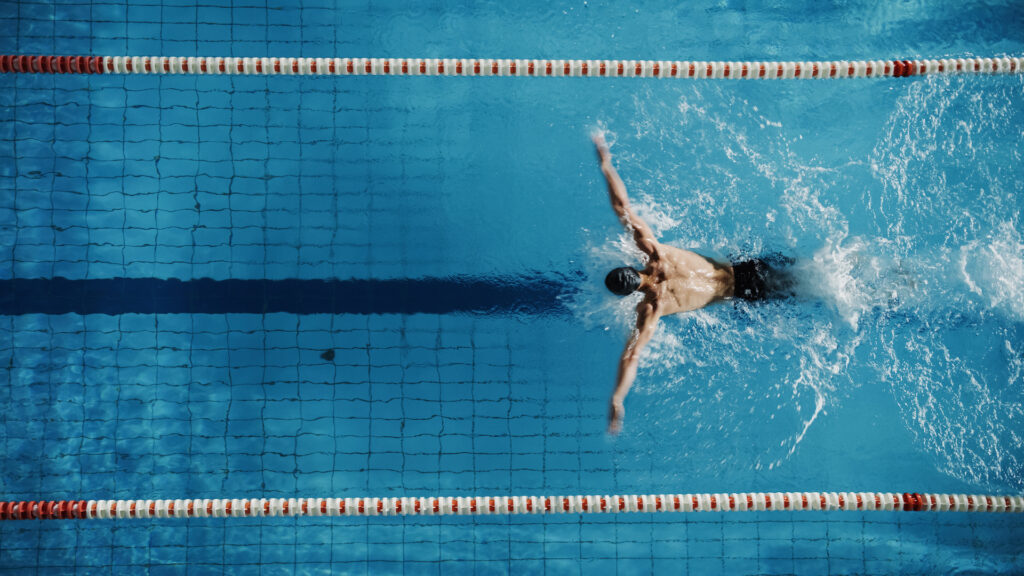“If there is magic on this planet, it is contained in water.” – Loren Eiseley
Recovering from addiction and mental health challenges requires a personalized and holistic approach. One such approach is incorporating movement and exercise, which can be supportive in a variety of ways.
Exercise as a whole has benefits for mental health and addiction recovery, but carrying out that exercise in an aquatic setting provides additional benefits, which we explore below.
The Healing Power of Water
Swimming is more than just a recreational activity—it’s restorative. Aquatic activities can significantly improve mental health, reduce symptoms of depression, and increase overall physical fitness.
Indeed, water is a powerful therapeutic environment, and aquatic exercise has a lot to offer.
To start, the natural buoyancy we experience in a pool helps us feel lighter and relax our bodies, taking the stress off our joints and allowing us to heal our bodies through stretching and movement. This is especially useful for those living with chronic pain.
Additionally, water provides a uniquely low-impact environment, reducing the likelihood of injury compared to activities like weightlifting. Water’s natural resistance helps us build strength, work small muscle groups, promote flexibility, and generally support physical rehabilitation.

Stress Relief and Mental Health Support
At the biochemical level, swimming or participating in water sports stimulates the release of endorphins—those feel-good chemicals that boost mood and reduce stress. But the benefits don’t stop there. The rhythmic nature of swimming, for example, encourages a meditative state, fostering mindfulness and mental clarity. Activities like water aerobics combine low-impact physical movement with a focus on breath and body awareness, which can significantly improve mental health by reducing symptoms of anxiety and depression.
In fact, swimming actually helps reduce anxiety. During the physiological stress of swimming, our heart rate spikes, our breathing rate increases, our chest tightens, and we experience significant physical discomfort. This familiarizes our bodies with the physical symptoms of anxiety and normalizes them, teaching the body that there is nothing to fear. To keep swimming, we must manage and control these sensations. This is true of all exercise, but unique to swimming, we must also control our autonomic impulse to breathe. While physiological alarm bells ring off, we override them and carry on swimming. For all of these reasons, swimming is a great way to inoculate ourselves against anxiety.
Regular participation in aquatic exercise can help regulate cortisol levels, the hormone associated with stress, further supporting emotional balance and resilience. Whether it’s the gentle resistance of water cradling your body or the therapeutic rhythm of each stroke, aquatic activities create a uniquely restorative environment that nurtures both the mind and body.
Physical Rehabilitation
Many people who come to our centres for treatment have pre-existing physical conditions, such as chronic pain, problems related to posture, ongoing complications from workplace accidents, and much more. These challenges can make traditional forms of exercise difficult or even counterproductive, as high-impact movements risk aggravating existing issues.
This is where aquatic exercise proves to be an invaluable tool. The buoyancy of water reduces the strain on joints and muscles, providing a safe and supportive environment for movement. This not only minimizes the risk of further harm but also allows individuals to engage in exercises that might otherwise be too painful on land.

Aquatic therapy can alleviate chronic pain, improve mobility, and even accelerate recovery from injuries. Additionally, water’s natural resistance offers a gentle yet effective way to rebuild strength, improve flexibility, and enhance balance.
Building Confidence and Resilience
What’s good for the brain is good for the soul. Engaging in new aquatic activities, whether it’s mastering a swimming technique or participating in a team sport for the first time, can have a profound impact on one’s sense of self. The process of learning and improving in the water helps to build self-confidence and foster a sense of accomplishment, both of which are essential for emotional well-being.
Psychological research consistently demonstrates that achieving mastery, even in small tasks, activates areas of the brain associated with self-esteem and motivation. The confidence gained through mastering a new skill or overcoming challenges in aquatic sports has far-reaching effects. It not only enhances one’s self-image but also strengthens resilience—the ability to persevere through setbacks and challenges.
This sense of achievement is particularly important in recovery, where rebuilding confidence is key to regaining independence and a positive outlook on life.
Swimming and Social Connection
Recovery is not just about connection with oneself—it’s also about connection with others. This is where group activities like water polo, aqua yoga, or simply swimming laps with a friend come into play. These activities not only promote physical health but also create opportunities for individuals to connect with peers who are navigating similar challenges. These relationships can significantly reduce feelings of isolation and support a sense of belonging.
This quality of connection that you make when playing a sport with somebody—especially if it’s something new to the two of you—lends itself really well to meaningful relationships and long-lasting friendships. Peer support and camaraderie form the foundation of a supportive network that strengthens individuals’ chances of a successful recovery, offering emotional and social benefits that last long after the activity ends.

Incorporating Aquatic Exercise Into Your Recovery Plan
If you’re considering integrating aquatic activities into your recovery journey, here are some tips to get started:
- Start Slowly: If you’re new to water activities, begin with something simple, like floating or walking in shallow water.
- Make It Fun: Choose activities that genuinely interest you—recovery is a long journey, and enjoying the process is essential.
- Stay Safe: After you’ve received medical clearance from a physician, always prioritize safety by using proper equipment, staying hydrated, and listening to your body.
Conclusion
Aquatic sports and exercise offer a unique and effective way to support your recovery journey. The combination of physical, mental, and social benefits makes water-based activities a powerful option for recovery, especially in the context of a holistic and personalized plan.
If you or a loved one is exploring treatment options, consider adding aquatic therapy to your personalized plan.
At Sunshine Coast Health Centre, we utilize a range of treatment modalities and therapeutic interventions. We take an approach that recognizes the importance of the physical, psychological, social and spiritual aspects of individuals in treatment and recovery. Contact us today to learn how our programs can help you find the balance, strength, and serenity you deserve.



